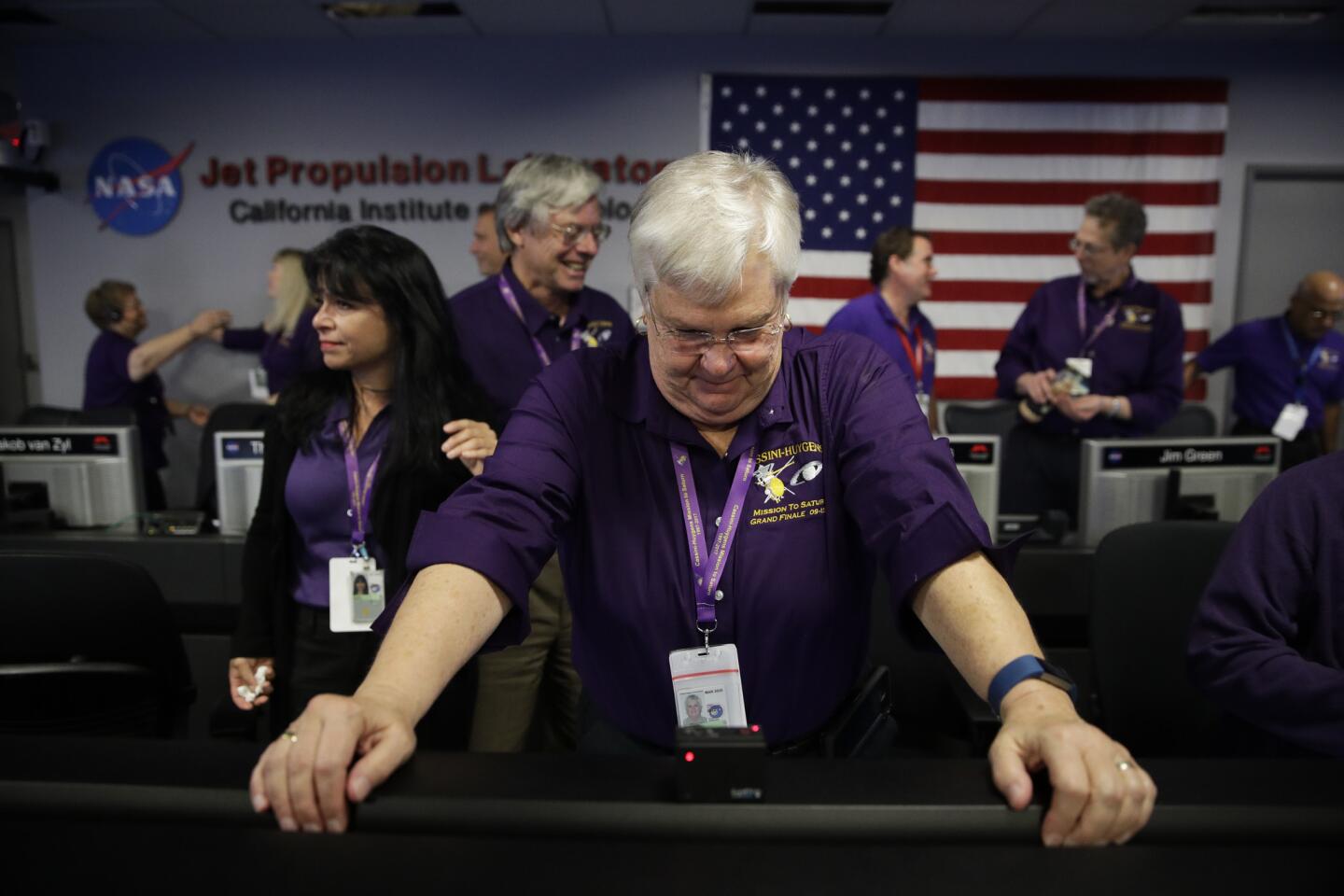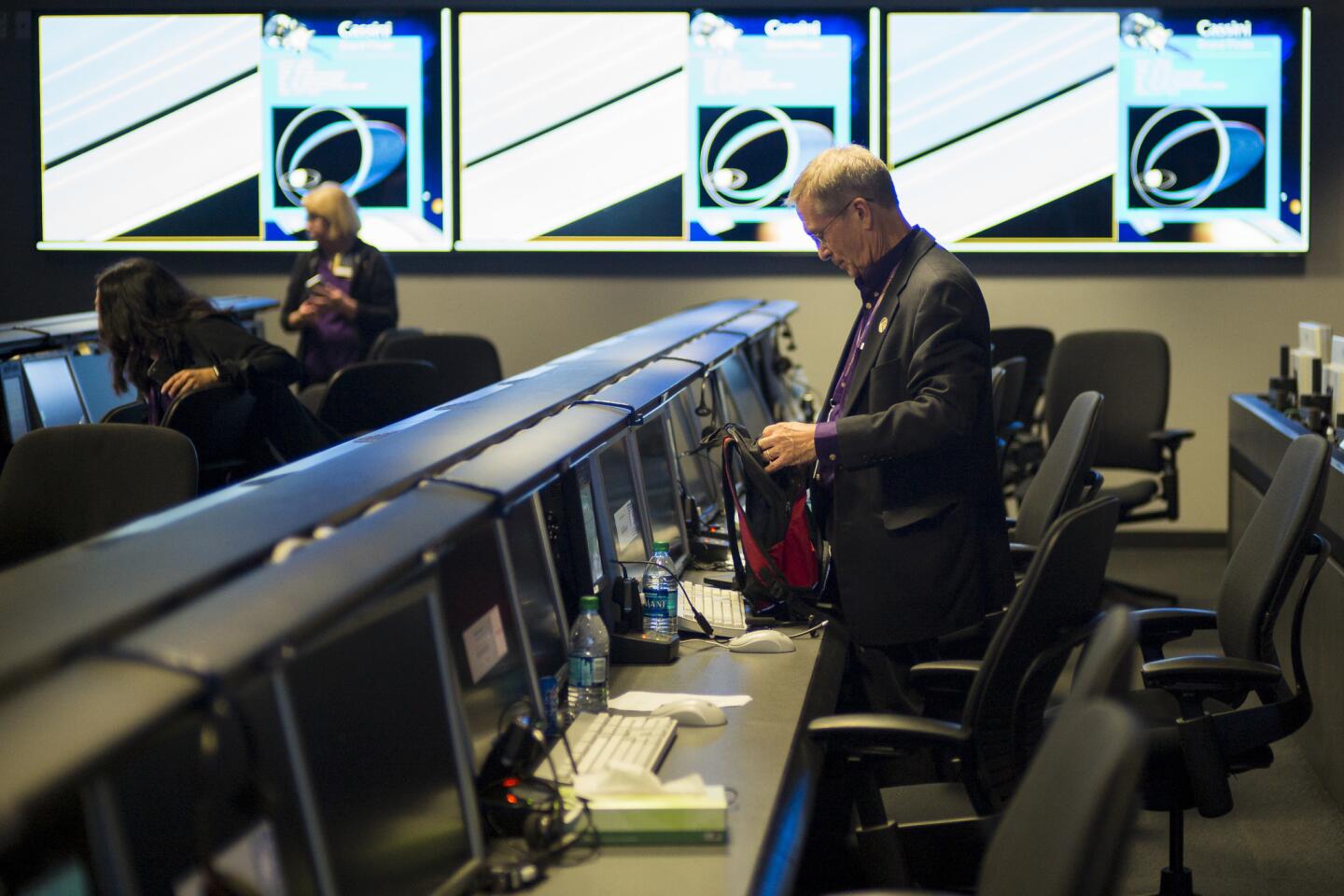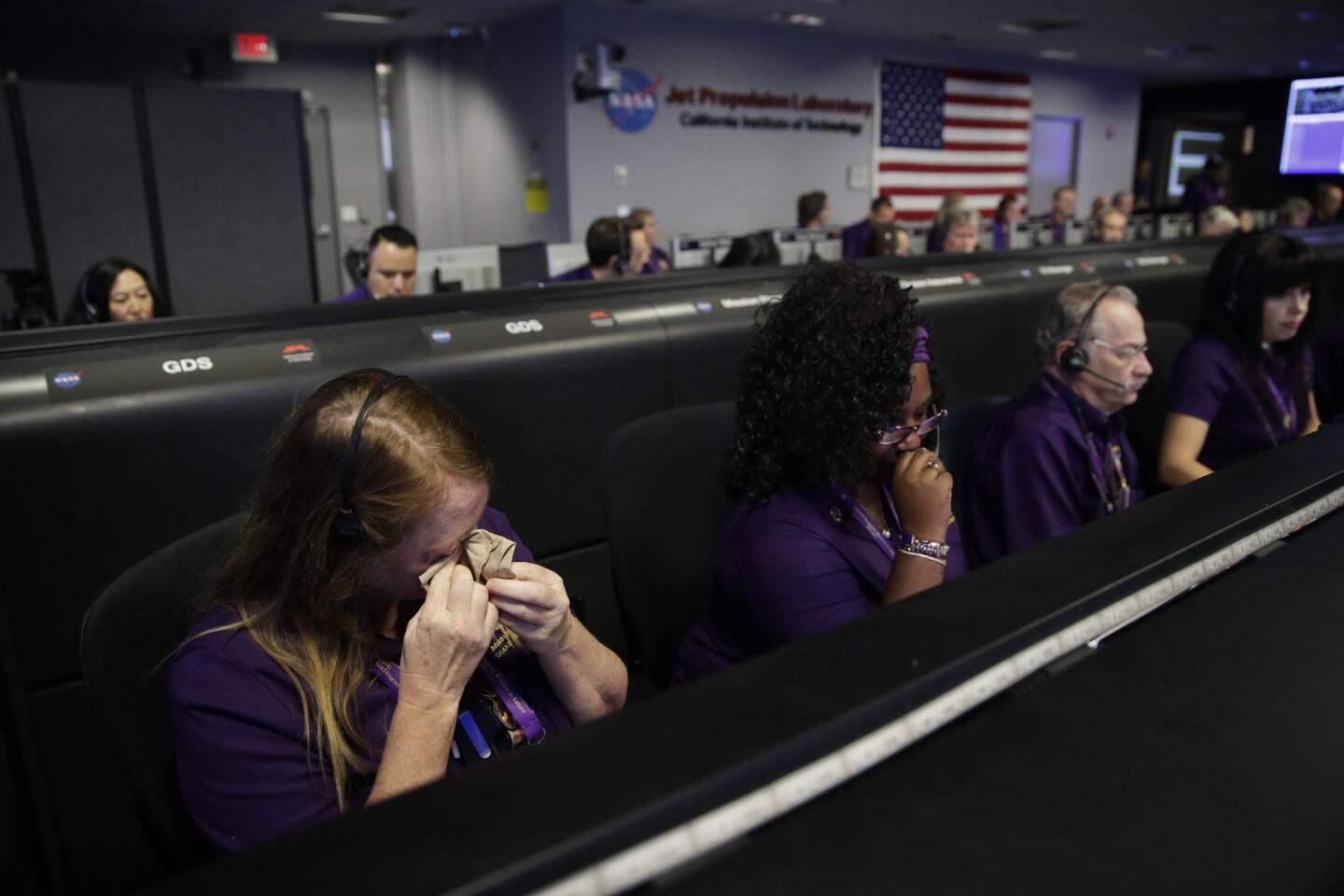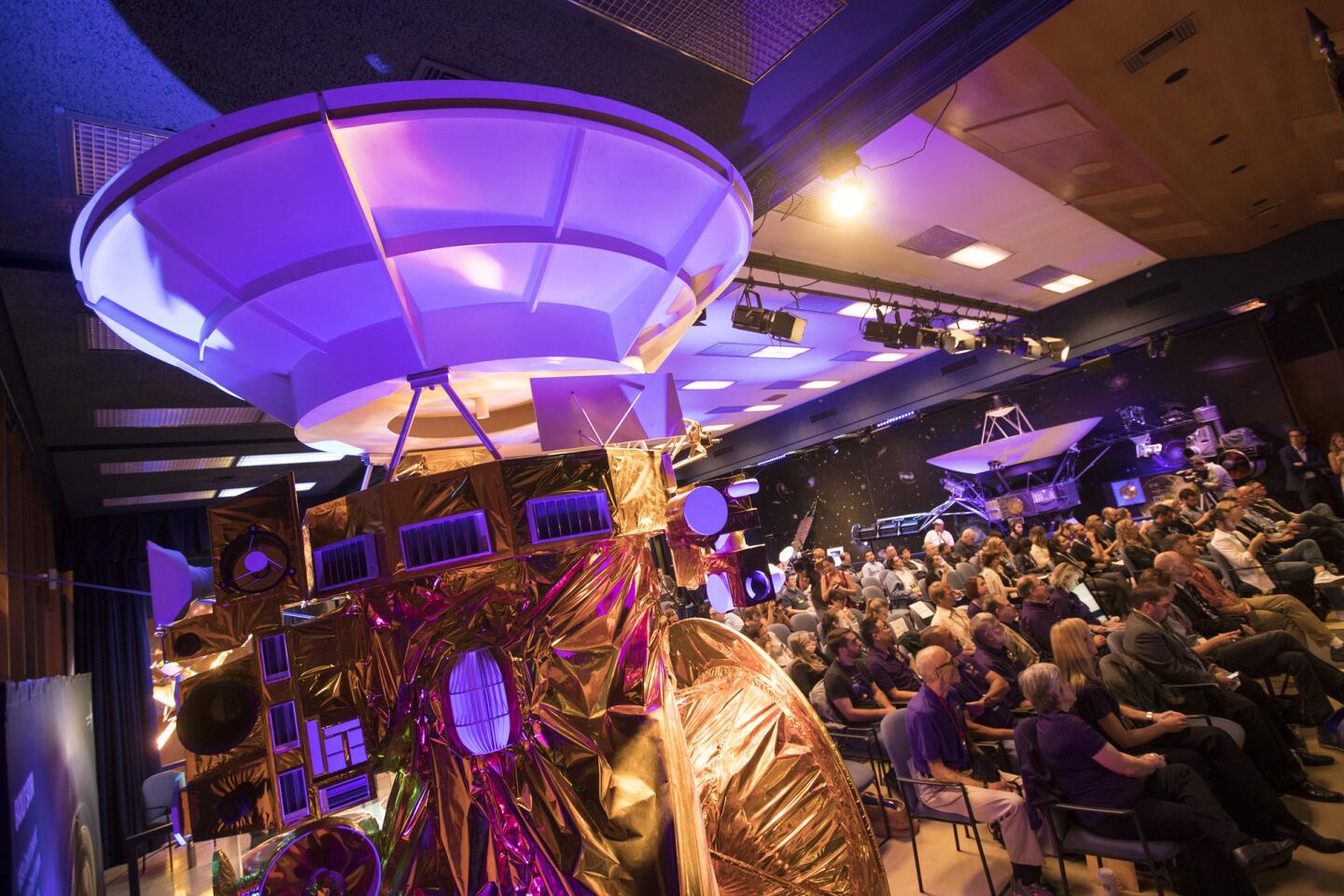Cassini, the NASA spacecraft that expanded the search for life beyond Earth, dies in Saturn’s sky
- Share via
Cassini, the NASA spacecraft whose breakthrough discoveries about Saturn and its many moons revolutionized the search for life beyond Earth, disintegrated Friday morning in the skies above the ringed planet. It was one month shy of its 20th anniversary in space.
The explorer’s death was swift and deliberate. Traveling at 76,000 mph, it hurtled into the planet’s atmosphere shortly after 3:30 a.m. Pacific time and stopped communicating with Earth one minute later, according to NASA’s carefully choreographed plan. Within three more minutes, Cassini’s 12 scientific instruments were torn apart. Then they melted. Then they vaporized.
An investigator to the end, the spacecraft transmitted scientific data about Saturn’s atmosphere and the planet’s interior structure throughout its final descent.
Cassini’s last signal to Earth was received at the Jet Propulsion Laboratory in La Cañada Flintridge shortly before 5 a.m. “We left the world informed, but still wondering,” Earl Maize, program manager for the mission at JPL, said before Cassini’s fateful descent. “I couldn’t ask for more.”
As NASA’s Cassini mission flames out over Saturn, scientists mark bittersweet end of mission »
Designed and built at JPL, the spacecraft was equipped with a suite of spectrometers, imaging radar and other scientific instruments. It was initially intended to spend four years studying the Saturnian system. However, Cassini was so robust — and the science it collected so startling — that NASA extended the mission. Twice.
During its 13 years at Saturn, it observed the birth of mini-moonlets in the dynamic rings and spotted massive hurricanes on the planet’s poles. It also found six new confirmed moons and a number of faint rings.
Among its most dazzling discoveries was the presence of hydrocarbon lakes and seas on Saturn’s largest moon, Titan, the only other body besides Earth in the solar system known to have standing liquid on its surface.
Full coverage of Cassini’s Grand Finale »
Even more stunningly, Cassini was the first to see great plumes of water ice particles gushing from fissures in the moon Enceladus — a find no one saw coming. After flying Cassini directly through the plumes, investigators worked out that the moon’s frozen surface concealed a global, salty ocean probably warmed by hydrothermal vents at the seafloor, another parallel to Earth.
Scientists now believe that Titan and Enceladus are two of the most promising candidates for hosting extraterrestrial life in the solar system.
“Thanks in part to Cassini, the habitable zone has been extended,” said Andy Ingersoll, a planetary scientist at Caltech. “It’s not just a band between Mars and Venus; rather, it includes an archipelago out into the outer solar system.”
In April, as Cassini’s demise grew increasingly imminent, the spacecraft began a series of 22 daring orbits that took it through the previously unexplored gap between the planet and its innermost ring. These observations are already challenging the conventional wisdom about Saturn’s magnetic field, atmosphere and internal structure.
“Many of the things we thought we knew about Saturn have turned out to be more complicated than we had first imagined,” said Linda Spilker, project scientist for the mission at JPL.

This motion graphic shows highlights of Cassini’s missions from 2004-2017.
Cassini was the last of NASA’s big missions to the outer solar system. It followed in the footsteps of Voyagers 1 and 2, which visited Jupiter, Saturn, Uranus and Neptune in the late 1970s and early 1980s, and of Galileo, which set off for a deeper study of Jupiter and its moons in 1989.
Maize said the spacecraft’s success was due in part to the experienced team that put it together.
“These are the folks who built the Voyagers and participated in a whole line of missions,” he said. “They had a tremendous amount of experience in interplanetary spaceflight.”
Of particular interest to Cassini’s architects was Titan, the only body in the solar system besides Earth with a nitrogen-rich atmosphere.
Voyager 1 flew by Titan in 1980, but its instruments couldn’t see beneath the moon’s thick orange haze. It did, however, detect organic molecules in the heavy fog. This suggested that a complex chemistry was occurring somewhere in the moon’s atmosphere that could mirror the early days of Earth before it had life.
The late Toby Owen, a planetary scientist at the University of Hawaii and a passionate advocate for the Cassini mission, described Titan as a “Peter Pan” world — “potentially like Earth, but with its development frozen in an early stage.”
To better explore this mysterious moon, NASA teamed up with the European Space Agency in the late 1980s. ESA built a Titan lander called Huygens that hitched a ride aboard Cassini and became the first spacecraft to touch down on a body in the outer solar system. In the 72 minutes it was operational on Titan’s surface in January 2005, Huygens beamed back images of what looked like riverbeds and a shoreline — the first evidence that the moon’s topography had been carved by flowing liquid.
All in all, more than 5,000 people from 17 countries worked on the Cassini-Huygens mission in some capacity. Cassini has logged 4.9 billion miles, captured 453,048 images and resulted in the publication of 3,948 research papers.
Though Cassini became one of NASA’s most successful exploratory projects, it almost didn’t happen. On at least two occasions, NASA officials came close to pulling the plug over concerns about its budget, which rose to about $2.5 billion before launch and totaled $3.9 billion over the entire mission.
In 1991 and again in 1994, an international outcry spearheaded by ESA officials who had already sunk large amounts of time and money into Huygens saved the mission from the chopping block. (Cassini’s planned twin, known as Comet Rendezvous and Asteroid Flyby, was canceled in 1992.)
“Now everybody looks back at the spectacular success, but there were some really dark days in the early ’90s,” said Julie Webster, Cassini’s chief engineer at JPL.
The mission faced other hurdles as well. Six years before launch, severe budget cuts stripped the spacecraft of its scan platform, a revolving arm that allows instruments to be pointed in any direction no matter which way the spacecraft is facing. In addition, the scope of many instruments had to be scaled back to meet new budgetary requirements.
Some mission scientists complained that the cost-cutting deprived them of valuable data. But most ultimately agreed that Cassini surpassed their expectations.
“Cassini had such great capability, and it was there for so long that you really could do everything,” Ingersoll said.
NASA engineers said Cassini’s instruments were still functioning at the time of its demise. The problem was that it had run out of propellant.
“If we were a car, the gas light would have come on years ago, and the needle is most definitely sitting on ‘E,’” said Todd Barber, Cassini’s lead propulsion engineer at JPL.
Mission planners decided the spacecraft’s complete destruction was necessary to prevent it and any of its remaining radioactive plutonium from ever crashing into — and perhaps contaminating — Titan or Enceladus. (The same decision was made with Galileo, which was deliberately crashed into Jupiter to eliminate the risk of contaminating the moon Europa.)
If any plutonium were to survive a crash landing, its heat could melt a moon’s water ice. In addition, fragments of the spacecraft might carry spores from Earth. Mix them all together in a life-friendly environment, and “you’d have a nice little concoction to get things going,” said Hunter Waite, director of planetary mass spectrometry at Southwest Research Institute in San Antonio.
There is no fear of that happening on Saturn.
“In this case, everything will eventually be sucked into the interior of Saturn and reprocessed,” Waite said.
Although Cassini’s journey has come to an end, scientists say they have only begun to scratch the surface of all the observations it made.
“We’ve had this fire hose of data for 13 years, and we’ve only skimmed the cream off it,” Spilker said. “Researchers will be working on it for decades, and I’m sure there are new discoveries that we haven’t made yet.”
Proposals to return are already under consideration as part of NASA’s New Frontiers program, including a Saturn probe and separate missions to Titan and to Enceladus.
“Already, Saturn is beckoning us to go back,” said Jim Green director of planetary science at NASA.
Do you love science? I do! Follow me @DeborahNetburn and “like” Los Angeles Times Science & Health on Facebook.
MORE ON THE CASSINI MISSION
‘OK. Let’s do it!’ An oral history of how NASA’s Cassini mission to Saturn came to be
Epic storms, new moons and worlds that might host life: Here are Cassini’s greatest discoveries
Check out Cassini’s jaw-dropping discoveries of Saturn’s moons



















